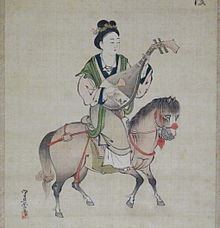Wang Zhaojun
Wang Qiang ( Chinese : 王 牆 or 王 檣 or 王 嬙) was the historical figure of the legendary figure Wang Zhaojun (王昭君) or Wang Chao Chün , who cannot be separated from one another perfectly. The imperial wife was one of the four beauties of ancient China , who in the 1st century BC. Lived during the Western Han Dynasty .
Emperor Han Yuandi sent these members of his harem - whom he did not know personally - as a bride to the Chanyu of the Xiongnu in order to keep the peace on the north-western border of the empire.
Life
Wang Qiang is believed to have been born in Baopin Village, Zigui Province , in what is now Hubei . She was pretty, intelligent, and very gifted in all of the four arts . When the Emperor Yuan in 36 BC When he ascended the throne, he had the most beautiful woman selected from each province of the empire and brought to the capital. Wang Qiang was sent to the imperial court in Chang'an as the most beautiful in her province, although she was still a minor . Unlike the other ladies-in-waiting , she refused to bribe the corrupt court painter Mao Yanshou. Mao made the portraits of the imperial concubines, according to which the emperor selected his visits. Due to Mao's unfavorable portrait, Yuan never visited Wang.
In 33 BC Chr. Chanyu Huhanye of the Xiongnu visited the imperial court to pay tribute to the emperor after a military defeat. In order to keep the peace with the barbarian prince in the long term, Yuan agreed to Huhanye's request to give him an imperial daughter to marry him. An actual relative of the emperor was out of the question as such a "daughter", which is why a volunteer was sought among the concubines who should be presented to the Chanyu as the emperor's daughter. Wang Zhaojun agreed to swap her luxury life in the harem for the tent of a barbarian prince.
The official, unappealing portrait of Wang was again presented to Emperor Yuan and he gave his approval. At the official presentation of the bride to her future husband, Yuan saw Wang himself for the first time, but now it was too late to reverse his decision. The court painter Mao was beheaded for deceiving the emperor. The emperor corresponded several more times with the beauty he had lost before he died that same year.
At the court of the Xiongnu, Wang became the Chanyu's favorite companion and bore him at least two sons and a daughter, of whom the son Yituzhiyashi (伊 屠 智 牙 師) and the daughter Yun (雲) survived; Yun later became an important figure as Yimuo in the Xiongnu- Xin relationships. After Huhanye's death in 31 BC. BC Wang Zhaojun asked to return home. Emperor Han Chengdi refused the request. Thus, according to the Xiongnu custom, Wang became the wife of the next Chanyu of the Xiongnu (either the brother or an elder son of her first husband). In this marriage she gave birth to two daughters. In the years in which Wang stayed with the Xiongnu, there were no conflicts with the Han empire, which is why she was revered as Ninghu Yanzhi (about: peacekeeping / good Hu consort).
Legends
There are over 700 poems and 40 folk tales about the legendary Wang Zhaojun. The more than 500 authors who sang about them include the ancient poets Shi Chong, Li Bai , Du Fu , Bai Juyi , Li Shangyin , Zhang Zhongsu, Cai Yong , Wang Anshi , Yelü Chucai and the modern day Guo Moruo , Cao Yu , Tian Han , Jian Bozan , Fei Xiaotong , Lao She , Chen Zhisui .
The best-known story, after which Wang Zhaojun also received her nickname, is that the sad lament of the exiles on their journey to the Xiongnu camp attracted a flock of geese, who then forgot to flap their wings and to the ground when they saw their beauty fell.
In Inner Mongolia there is a burial mound with pagodas and statues, which reminds of Wang Zhaojun. It came into being long after her death; the woman's actual resting place is unknown.
Web links
Individual evidence
- Antonius Lux (ed.): Great women of world history. A thousand biographies in words and pictures . Sebastian Lux Verlag , Munich 1963, p. 104.
| personal data | |
|---|---|
| SURNAME | Wang, Zhaojun |
| ALTERNATIVE NAMES | Wang, Qiang; Wang, Chao Chun |
| BRIEF DESCRIPTION | Chinese concubine of the Han emperor Yuan |
| DATE OF BIRTH | around 50 BC Chr. |
| DATE OF DEATH | 1st century BC Chr. |
